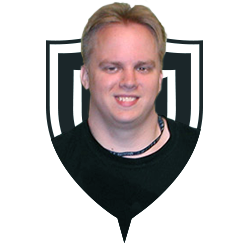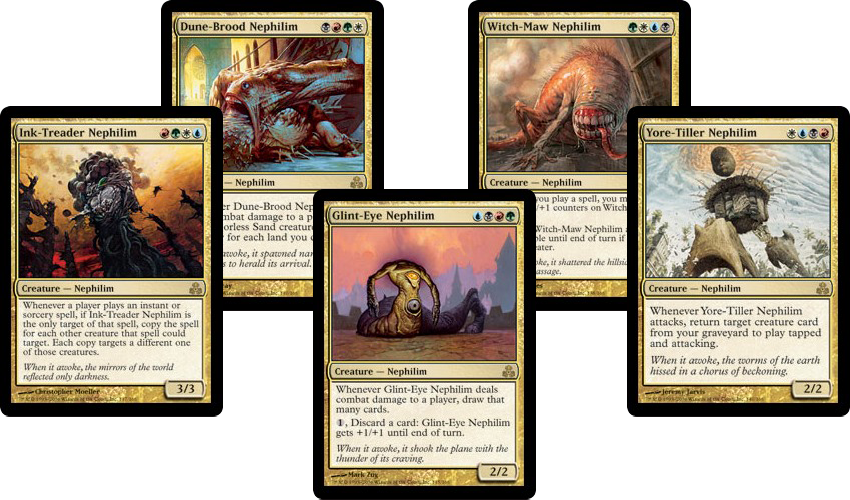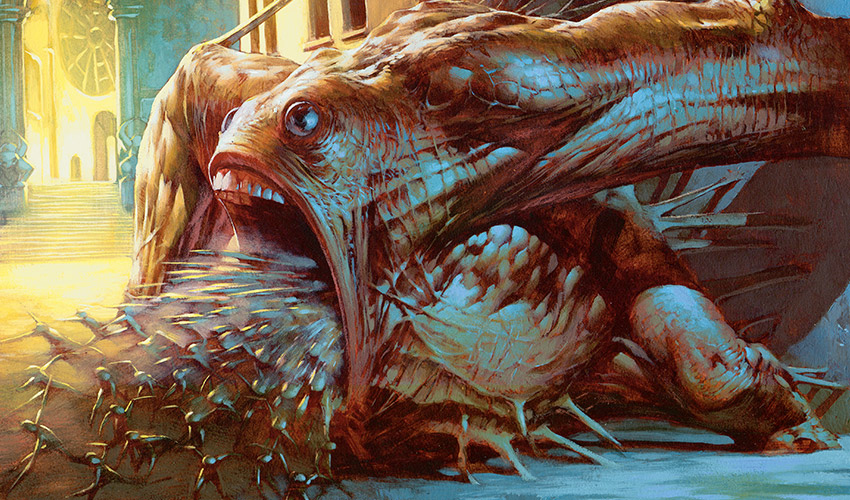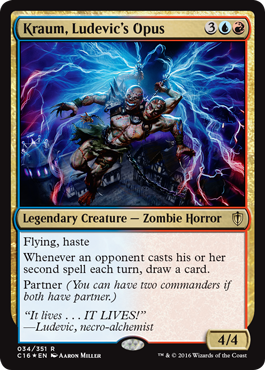Howdy Partner
Welcome to Commander (2016 Edition) Preview Week. This week we'll be talking all about the new series of Commander decks coming soon to a game store near you. I'm going to be discussing how the product got its theme and what problems had to be solved to do it. I'll also be revealing two preview cards showing off that theme. But before I do that, I want to start, as I always do, by introducing the Commander (2016 Edition) design team.
Ethan Fleischer (lead)

This is the fourth time for Ethan on a Commander product and the second time as the lead. (Ethan led Commander (2014 Edition) and Commander 2016—I guess he likes even years.) Ethan originally got his job by winning the second Great Designer Search. He's been in R&D for four years now. In that time, Ethan was the design lead on Journey into Nyx and Oath of the Gatewatch as well as co-lead for Amonkhet (the large set that comes out early next year) with me. Ethan is a very inventive designer and I'm always impressed by the work he and his team do. Commander 2016 was no exception.
Sam Burley

One of the cool things about working in R&D is that you have the chance to contribute to design even if that's not the focus of your job. Sam is a concept artist working on the creative team. It's his job to visually flesh out new sets/worlds to help turn concepts into more concrete ideas. The creative team then uses those ideas to begin to craft the world and communicate future sets/worlds to the rest of the company. We work hard to bring different viewpoints to design teams, and part of that is getting people with an alternate perspective from the normal designers and developers. Sam is very enthusiastic and full of ideas, and was an excellent addition to the design team.
Alli Medwin

Alli was in a situation similar to Sam's. She sits in the Pit, but her day job is not designing Magic but rather editing Magic Online. She loves to design Magic cards in her spare time though, and had been eager to land a spot on a design team. Commander 2016 was that opportunity. Alli did not disappoint, jumping into the project whole-heartedly and delivering many memorable card designs (and the template for the main mechanic in the set).
Ken Nagle

Ken is one of the biggest advocates of the Commander format in R&D and led the design of Magic: The Gathering—Commander (our first Commander release back in 2011). The runner-up in the first Great Designer Search, Ken has become a veteran designer having led numerous design teams (Worldwake, New Phyrexia, Return to Ravnica, Born of the Gods, Fate Reforged and Eldritch Moon; Ken is also co-lead on "Ham", the fall set of 2017, with me). Ken is a fire hose of ideas and is always invaluable on a design team. As you will see, he proved integral to solving the major challenge of the Commander 2016 design.
Robert Schuster

Like Alli, Robert also works on Magic Online. If you've ever visited the Magic Online Tumblr, you've seen his handiwork. (He also does the graphics for my Head-to-Head online matches when cards face off against one another.) Robert is both fun and insightful, and provided a unique vantage point for the Commander 2016 design team.
Four Cast
There are gaps in the Commander format, but no gap is more high-profile than four-color commanders. Magic has many choices for one-, two-, three-, and five-color commanders, but currently zero four-color commanders. In fact, in all of Magic, there is only one cycle of four-color creatures, the Nephilim from Guildpact. (And yes, with 20/20 hindsight, we should have made them legendary.)

When we were choosing the themes for the very first Commander products (back when it was just part of our summer innovation product line and not yet its own thing), four-color decks were high on the list. In the end, the team went with a three-color theme for the same reason that in over 16,000 cards, we've only ever made each four-color combination once: it's just very hard to design four-color cards. The lack of any color focus means they tend to end up very soup-y and without a clear definition.
Once the Commander decks became an annual product, we were faced with coming up with more and more themes, and each time four-color decks came up, the design team chose a different option. Shards, wedges, monocolor, enemy two-color—we did just about everything but four-color. For Commander 2016, we decided it was time for us to finally figure out how to make four-color work.
Ethan and his team started the design by asking themselves what were all the possible ways to make four-color decks. Here are some of the things they tried:
- Four-color legendary creatures
The team was able to design one cycle (there's one in each deck), but the design space for four-color creatures was just as wonky as it's always been. The design team tried making more, but they weren't happy with anything other than the cycle they ended up using.
- Three-color legendary creatures with an off-color activation
The design team knew they could design three-color legendary creatures. Two of the previous Commander decks had been built around them. To make them have a four-color identity, all they would need to do was have an off-color activation using the fourth color. There are ideas that sound interesting in concept up until you actually design cards—this idea falls into that bucket.
- A two-color hybrid legendary creature with a different two-color hybrid activation
Imagine a red-green creature with stats and abilities that overlap red and green (like a 4/4 trampler). Then imagine an activation using a different hybrid activation, like a white-black activation that gives the creature lifelink until end of turn. This execution had a few problems. First, while the first creature usually turned out okay, further designs got harder and harder as you used up the small amount of hybrid design space between the two colors. Second, color identity is already a little tricky, and hybrid mana made it a lot more confusing when we did testing.
- Artifact creatures with Phyrexian mana
This was one of the wilder ideas. All the legendary creatures would be artifacts, but they would have various colored Phyrexian mana symbols. (You can spend 2 life instead of providing the appropriate color mana.) This would allow the creature to have a color identity without the player necessarily having to support all four colors in their deck. This idea also had numerous developmental issues.
Ethan and his team were getting frustrated. They knew they had taken on a difficult challenge, but nothing was working. That's when Ken suggested a different take on the problem.
Split Verdict
The story of the solution starts during Return to Ravnica design. One of the responsibilities of the design team for Return to Ravnica was to figure out which aspects of Ravnica were supposed to return and which ones weren't. For those that returned, we wanted to recapture what made the mechanic enjoyable the first time around and then see if there was any room for tweaks.
Original Ravnica block had used split cards, so Ken (as the design lead of the set) was trying to figure out whether or not we wanted to bring them back. Ken came up with a tweak where the player had the ability to cast either part of the split card (like normal) or both. Ken had always wanted this option when playing the original split cards. This ability, called fuse, ended up being saved for Dragon's Maze, but it got Ken thinking. One cycle of the mechanic had one two-color card on one half and then a different two-color card that overlapped with the first two-color combination on the other half. Ken felt like the cards had a flavor of two guilds working together. (Interestingly, when we first made the Nephilim for the original Ravnica block, I suggested they be flavored as two guilds working together—but as the cycle was made as a means to give players who might not be into the guild structure something to enjoy, I was discouraged from connecting the four-color Nephilim to guilds.)

Flash forward to Commander 2016 design. The obvious four-color designs weren't working out, so the team was getting creative. Ken thought back to the fuse split cards and wondered if there was a way to do something similar, but with creatures rather than spells. There wasn't a way to do it with a single card, so Ken made a leap. What if you did it with two cards instead? What if you combined two different two-color cards through a mechanic rather than both being on the same card? And that is how the idea for partner was first formed.
Here's how partner works: when choosing your commander, you are allowed to choose two legendary creatures that both have partner in place of a singular legendary creature. All the legendary creatures with partner in Commander 2016 are two-color, some ally color and some enemy color. Here's the actual text: "Partner (You can have two commanders if both have partner.)"
The design team started by making two legendary creatures with partner per deck. One would be an allied two-color creature while the other would be an enemy two-color creature. By having this pair of partner creatures along with a four-color legendary creature, each deck would have two different options to use as its commander (or commanders).
Ben Hayes, the lead developer of Commander 2016, really liked partner and suggested that they increase the number of creatures with partner per deck. He did this by adding a second enemy color legendary creature with partner. (They chose an additional enemy color creature because Magic has a lot more legendary ally two-color creature than enemy.) That way each deck now had three different options for its commander—the four-color creature or two different combinations of the partner creatures, the ally two-color creature along with one of the two enemy color two color creatures.
Savor the Flavor
Ethan's vision for Commander 2016 had one other component. Ethan has always been a big fan of Magic's story, so when he made Commander 2014, he worked with the creative team to make as many of the new legendary creatures (and planeswalkers—that was the main theme of Commander 2014) characters from the past that had never received a card. This aspect of Commander 2014 had been very successful, so Ethan was eager to try it again. In fact, one of my preview cards is a character I've been trying to get made into a card for years.
I was one of the two creators of the Weatherlight Saga (along with a former employee named Michael Ryan) from way back when. The main character of the story was a man named Gerrard. In the backstory, Gerrard was foretold to play a major role in overcoming the threat of the Phyrexians, so his parents needed to hide him away to keep him safe. They ended up passing that responsibility to a man known as Sidar Kondo. Sidar is synonymous with "chieftain," as Kondo was a leader of his people. Kondo adopted Gerrard and raised him as his own child along with his biological son, Vuel. Things would go badly between Gerrard and Vuel, and Vuel eventualy killed his father and ran away, later becoming the villain Volrath ("Vuel of Rath") in the process.
Sidar Kondo got turned into a Vanguard card (a special format where players used cards that changed their starting life and hand size in exchange for having an ability during the game), but never made it into an actual Magic card.
I tried making a Sidar Kondo card during Time Spiral, but the leader of the creative team felt Kondo wasn't well-known enough and rejected the idea. I mentioned this once in passing to Ethan. Then, during Commander 2016, Ethan was trying to find a character that made sense for a green-white legendary creature. He asked me if Kondo might be green-white, and I said yes.
So am I very excited to share my first Commander 2016 preview card, Sidar Kondo.
Click Here to Meet Sidar Kondo!

Ethan gave Kondo flanking as he came from Jamuraa, the setting of the block Mirage, which first introduced the mechanic. As a leader of people, his second ability helps enhance his team.
For all the new two-color legendary creatures, Ethan and his designers worked with the creative team to find cool characters from the past that had yet to have their own Magic card. The four-color creatures were made as new characters, but each from known Magic worlds. The two enemy color legendary creatures were created such that they had a link to one another. My second preview card shows off half of one of these links.
One of the characters that players have been clamoring to have as a card is Ludevic, one of the mad scientists from Innistrad. Ludevic is getting printed in Commander (2016 Edition) as a blue-red legendary creature. He's not my preview card today (we're saving him to preview later this week), so instead I'm going to introduce you all to Kraum, Ludevic's favorite creation. His opus, if you will.
Click Here to Meet Kraum, Ludevic's Opus!

To recap, there are five decks for Commander (2016 Edition). Each deck will focus on four colors. Each deck will contain fifteen new cards (although note that some new cards may appear in more than one of the decks). Among these fifteen new cards, each deck will have:
- A four-color legendary creature (new characters but from known worlds) printed at mythic rare
- An allied two-color legendary creature with partner (characters from Magic's past that haven't yet been printed as cards) printed at mythic rare
- Two enemy two-color legendary creatures with partner (characters from Magic's past that haven't yet been printed as cards that are creatively linked to one another), one printed at mythic rare and the other at rare
- Various other cards tied to the mechanical theme of the deck
Each deck will have three legendary creatures with partner, allowing you three options of partnering (although one version will only give you access to two colors). If you buy all five decks, you will have fifteen legendary creatures with partner, giving you 105 different pairing options.
For more on how this design came together complete with the full vision straight from the lead designer, make sure to take a look at Ethan Fleischer's article also being published today.
"Four!"
Four-color commanders were definitely a long time coming, but I think we took our time so when we did them we could do them right—and Commander (2016 Edition) is that product. So to all of you who have sent me many requests for four-color commanders over the years, please enjoy!
As always, I am eager to hear feedback from all of you. What do you think of our new four-color commanders? Of the partner mechanic? Of Commander (2016 Edition)? Of this preview article? If you have feelings—positive thoughts or constructive criticism—please let me know either through my email or any of my social media accounts (Twitter, Tumblr, Google+, and Instagram).
Join me next week for my third and final "Odds & Ends: Kaladesh" column, where I'll answer more of your questions all about Kaladesh.
Until then, may you enjoy finally having some four-color commander options.
In this podcast, I talk about being a magician in my youth and what I learned from that job involving magic that I brought to my modern job involving Magic.
"Drive to Work #377—Top 20 Creatures"
This podcast is a Top 10 podcast that goes the extra length to become a Top 20 podcast. I talk about my 20 favorite creature types.
- Episode 375 20 Lessons: Details Matter (25.1 MB)
- Episode 374 Discontinued Rules (20.6 MB)
- Episode 373 Perspective (20.7 MB)

